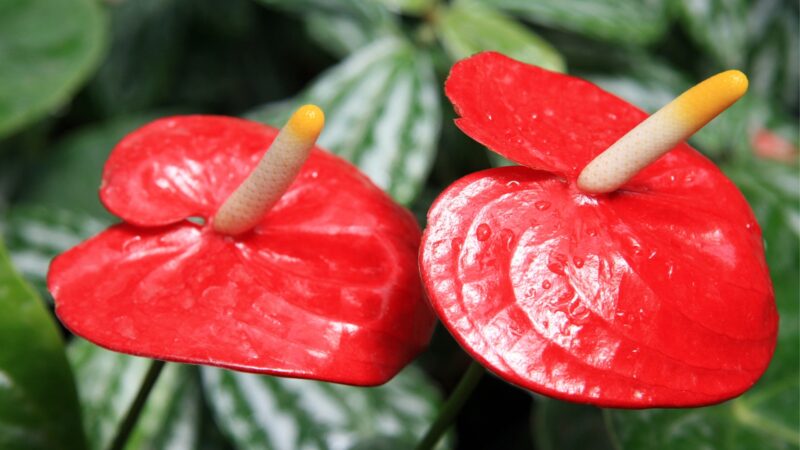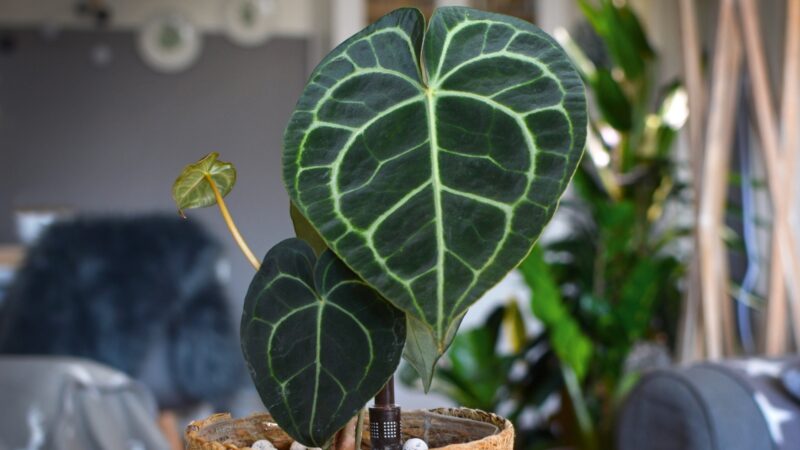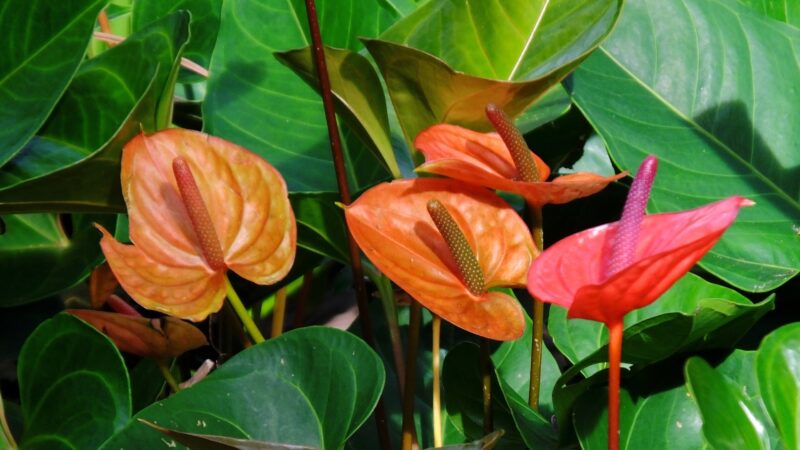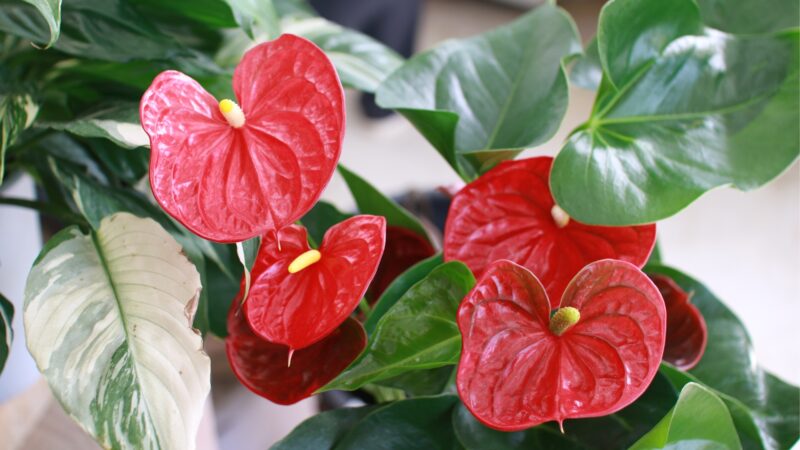Flamingo lilies, or anthuriums, are known for their heart or arrow-shaped foliage and long-lasting flowers that can bloom several times a year. They are relatively easy to grow and take care of since they require little attention and maintenance.
To take care of a flamingo lily, grow it in a coarse, well-draining, preferably peat-based potting mix, and apply a fertilizer with high amounts of phosphorus.
Then, place it in a location where it can receive bright, indirect light, temperatures between 78°F to 90°F, and high humidity. Allow it to dry slightly between waterings and repot if new roots start to grow.
To know more about growing and taking care of a flamingo lily, its best available varieties, toxicity, propagation methods, and other interesting information, read further this article!
What Is a Flamingo Lily?

Anthuriums are slow-growing, tropical evergreen shrubs that are commonly grown as perennials with upright growth and multiple stems. They are houseplants known for their heart-shaped leaves and brightly-colored flower spathes and spadices but are also used as flowering displays or specimen plants.
How to Identify Flamingo Lily?
Flamingo lilies have bright, showy, large flowers that arise from glossy or leathery hearts or arrow-shaped leaves. They usually have long stems but will shorten as they age.
Another way of identifying this genus is its long, narrow spadix which is a fleshy spike covered with numerous small flowers.
How Long Do Flamingo Lily Live?
With proper care and maintenance, anthuriums can live up to 5 years.
Is Flamingo Lily Poisonous To People And Pets?
The flamingo lily has high poison severity, which can cause contact dermatitis, irritation of the mouth or eyes, and digestive symptoms when ingested due to the calcium oxalate crystals present in its plant parts.
Anthurium Varieties
Painter’s Palette (Anthurium Andraeanum)

A herbaceous evergreen, upright-growing plant and one of the most popular anthurium varieties, the Painter’s Palette grows up to 40 centimeters in height.
It is characterized by its glossy, dark green foliage, bright red spathe, and small, yellow round fruits. It is most suitable as an indoor plant.
Velvet Cardboard Anthurium (Anthurium Clarinervium)

This variety is named after its velvety, deeply-lobed leaf surface that has a deep forest green color and pale green, whitish, silver, or gold-colored concentric veins.
The Velvet Cardboard Anthurium produces orange berries and small pale green flowers with violet hues. It is typically grown in tropical environments but can be planted indoors.
Flamingo Flower (Anthurium Scherzerianum)

The Flamingo Flower was given the Award of Garden Merit by the Royal Horticultural Society due to its value as an ornamental houseplant. It reaches up to 45 centimeters in height.
Also, it is known for its striking, long-lasting red-orange curling spadix flower and orange, pink, or red spathes. It also has shiny, lance-shaped leaves.
Pheasant’s Tail (Anthurium Schlechtendalii)
A broad-leafed variety that is widely used for several medicinal purposes such as treating arthritis, joint and muscle sprains, rheumatism, and back pains, the Pheasant’s Tail is characterized by dark green leaves, white aerial roots, and a dark purple bract. It produces small red fruits and a narrow, brown spadix.
King Anthurium (Anthurium Veitchii)
One of the largest species of anthurium, the King Anthurium can easily grow up to 182 centimeters. It is available as a narrow form or wide form in the market, referring to its corrugated, brown, or rusty leaves and the distance between their lateral veins. This plant used to be rare but is now commercially available due to several tissue cultures being sold.
How to Take Care of Flamingo Lily?
Lighting
Flamingo lilies prefer medium to bright but indirect sunlight when planted indoors for optimum flower production. Too much shade will halt bloom growth altogether. However, when planted outdoors, they thrive in low-light conditions.
Water
If you live in a hot and humid area, water once every 2 to 3 days. Otherwise, water as necessary. Allow the plant to dry slightly between waterings.
If the upper surface of the soil is dry to the touch, then it is time to water the plant. Remove dust from the foliage of the plant by regularly wiping them off.
Temperature and Humidity
Anthuriums thrive in day temperatures between 78°F to 90°F and night temperatures between 70°F to 75°F. They are not cold and frost tolerant. When planted outdoors, they prefer temperatures of 60°F to 85°F.
Since they require a slightly higher level of humidity, regularly mist weekly or add 1 to 2 inches of pebble stones in the bottom of their container.
Soil
Use a coarse, well-draining potting mix, preferably with peat moss as a base. A mixture of pine bark, peat moss, and perlite at a ratio of 1:1:1 or cactus and orchid mixes at a ratio of 1:1 can also work.
However, young plants should be planted in soil that can hold moisture well. The soil should settle firmly around the roots.
Fertilizer
Generally, flamingo lilies require little fertilizer. Apply a complete fertilizer, slow time-release fertilizer, or liquid fertilizer with organic supplements every other month or following the product label. Using products that are formulated with high phosphorus content can encourage blooming.
Potting and Repotting
Use porous (terracotta, clay, or unglazed ceramic) or semi-porous (pressed fiber or wood) containers since they are well-draining. Allow the root system to fill the entire pot before repotting. You can also repot if new roots start to grow.
When repotting, use a 6 to a 7-inch pot filled halfway with rocks and an organic, well-aerated potting mix. A suitable medium would be a mixture of orchid peat, sphagnum moss, and leaf mold at a ratio of 3:1:1 supplemented with a sprinkle of coarse sand, broken bricks, and crushed charcoal.
How to Propagate Flamingo Lily?

By Stem Cutting
Step 1: In the early morning, select cuttings from a healthy, disease-free plant, preferably on its upper part with no flowers or flower buds present. Cut from lateral shoots since they root better than terminal shoots.
Step 2: Use sharp pruning shears or other sterilized cutting tools to select cuttings that are 4 to 6 inches long.
Step 3: Remove leaves at the lower one-third part of the cutting. Then, treat using a rooting hormone to stimulate growth.
Step 4: You can choose to keep them cool and moist or insert them right away into a well-draining rooting medium. One-third to one-half of the length of the cutting should be inserted into the medium, with its buds pointing up.
Step 5: Cover the cuttings using clear plastic, then place them in a location where they can receive bright but indirect light.
By Division
Step 1: Perform this method in the dormant season of the plants, just before the new growing season begins or in the fall.
Step 2: Using a fork or spade, dig up the parent plant, then gently lift it out of its container or the ground. Remove any loose dirt that surrounds the roots.
Step 3: Make the divisions by any of these methods:
- Pulling or teasing the roots apart using gloved hands.
- Cutting the roots using a spade or sharp knife.
- Using two forks to pull apart the roots at the center of the clump.
Step 4: Each division should have 3 to 5 vigorous shoots growing out of them, as well as a healthy supply of roots.
Step 5: Place these divisions in a different container from the original plant.
From Seed
Step 1: Choose a substrate. It may be a combination of sterilized soil, peat moss, vermiculite, sand, or perlite. You can also select commercial mixes.
Step 2: Fill a container with a moistened substrate of your choice, then sow in the seeds thinly and uniformly in rows. Do so by lightly pressing them into the medium.
Step 3: Cover the seeds with the sifted substrate or dry vermiculite.
Step 4: Dampen the potting mix thoroughly by placing the container in a tray containing an inch of warm water once the seeds have been sown in. You can also mist the seedlings.
Do Flamingo Lily Flower Every Year?

Flamingo lily does flower every year. They can bloom up to 6 times a year, and each can last about 2 to 3 months long, depending on its environmental conditions and overall plant health.
How Do I Get My Flamingo Lily to Bloom?
Following the care guide is the ultimate way of getting your flamingo lily to bloom. This means using a well-draining potting mix and using a fertilizer with high phosphorus content.
Additionally, it also means watering thoroughly but allowing the soil to dry out slightly between waterings, and placing it in a location where it can receive bright, indirect sunlight, high humidity, and temperatures of 78°F to 90°F.
Common Problems With Flamingo Lily
- Lighting. Too much light will produce brown leaf tips and bleached centers, while too little light will halt flower production.
- Watering. If the plant is overwatered, yellowing leaves and root damage can be observed. If the plant is under-watered, tip burn and root damage can occur.
- Lack of blooms. This may be a sign for you to repot your plant as its new roots are starting to outgrow its container. It may also be caused by not receiving enough phosphorus or insufficient light.
- Insects. Aphids, mealybugs, scales, gnats, and thrips are common pest problems for anthuriums. To prevent their appearance, do not allow the plant to be constantly wet. Wipe its foliage regularly.
List of Sources
Anthurium – https://plants.ces.ncsu.edu/plants/anthurium/
Anthuriums – https://gardeningsolutions.ifas.ufl.edu/plants/ornamentals/anthuriums.html
Tropical Foliage Plant Development: Breeding Techniques for Anthurium and Spathiphyllum